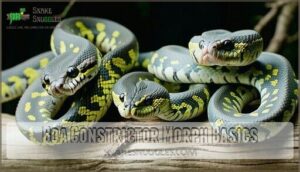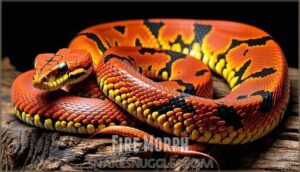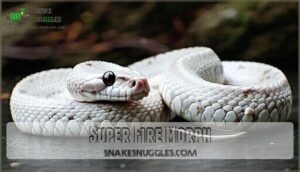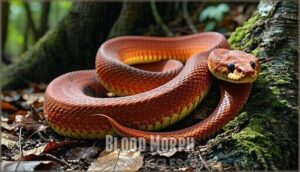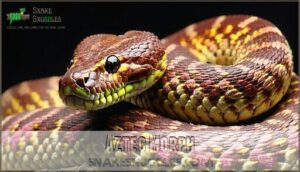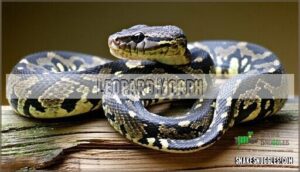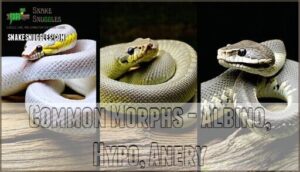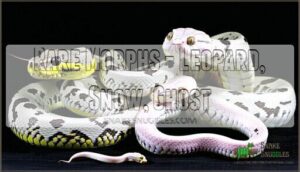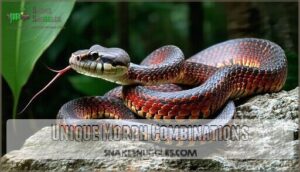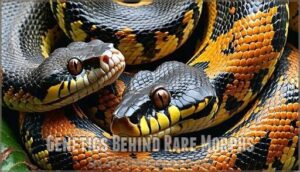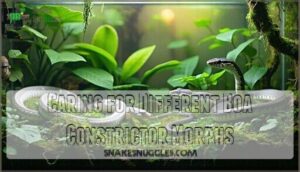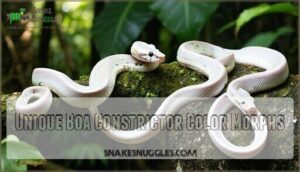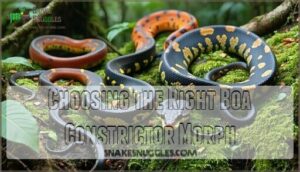This site is supported by our readers. We may earn a commission, at no cost to you, if you purchase through links.
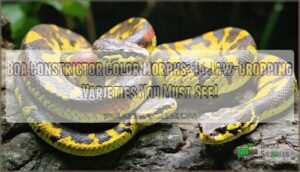
You’ll find popular ones like albino morphs with golden-yellow tones and vivid red markings, hypo morphs with softer, reduced black pigmentation, and anery morphs that replace reds with cool grays.
Rare morphs, such as the leopard or snow, combine striking patterns with unique hues, making them real conversation starters.
These morphs arise from selective breeding and genetic traits, offering endless possibilities in color and design.
If you’re fascinated by reptiles, boa morphs blend science and style into one amazing package.
There’s much more variety than meets the eye, and boa constrictor color morphs are a great example of genetic variations.
Table Of Contents
- Key Takeaways
- Boa Constrictor Morph Basics
- Popular Boa Constrictor Color Morphs
- Common and Rare Boa Constrictor Morphs
- Caring for Different Boa Constrictor Morphs
- Unique Boa Constrictor Color Morphs
- Choosing The Right Boa Constrictor Morph
- Frequently Asked Questions (FAQs)
- What is a boa constrictor morph?
- What color is a boa constrictor?
- How do you know if a boa constrictor morph is rare?
- Why do boa constrictor morphs change color?
- Do albino boas have constrictor morphs?
- What is a boa morph?
- What color patterns do boa constrictors have?
- What is the rarest Boa?
- What is the difference between a BCI and a BCC?
- Do all IMG boas turn black?
- Conclusion
Key Takeaways
- You’ll see boa morphs showcase stunning genetic variations, creating diverse colors and patterns while keeping the same species.
- Breeding strategies and ethical practices are key to ensuring healthy, vibrant morphs without genetic disorders.
- Environmental factors like lighting, humidity, and temperature greatly influence how morphs express their colors and patterns.
- Rare morphs like Snow, Leopard, and Ghost stand out for their unique genetics and high value among enthusiasts and breeders.
Boa Constrictor Morph Basics
You’ll find that boa constrictor morphs are genetic mutations that change a snake’s appearance while keeping it the same species.
These mutations affect DNA sequences that control pigment production, creating the stunning variety of colors and patterns you see in captive-bred boas today, which are a result of genetic mutations.
What is a Boa Morph
Understanding a boa morph begins with genetics. A boa morph is a boa constrictor showing specific genetic mutations that alter its visual appearance while maintaining breed consistency.
A boa morph showcases the artistry of genetics, where unique mutations craft striking beauty while preserving the essence of the species.
- Morphs result from DNA sequence changes affecting pigment production
- Each morph has unique color patterns distinct from wild-type boas
- Hundreds of morphs exist, with new variations discovered regularly
- Morphs differ from birth defects, which affect anatomy and functionality, highlighting the importance of understanding genetic mutations.
Genetics Behind Boa Morphs
The genetics behind boa morphs shape every scale and color you’ll see in these magnificent reptiles.
Like a genetic blueprint, each morph develops from specific DNA instructions.
| Gene Type | Inheritance Pattern | Example Morph |
|---|---|---|
| Dominant | Needs one copy | Fire |
| Recessive | Needs two copies | Albino |
| Co-dominant | Shows in heterozygotes | Jungle |
When boa constrictor genetics combine, they create stunning variations through polygenic inheritance.
Some gene combinations produce vibrant morphs, while others may lead to morph incompatibility.
Ethical breeding practices maintain genetic diversity, ensuring healthy snakes with beautiful patterns.
Snake genetics operate like puzzle pieces – each genetic mutation contributes to the finished picture of your boa’s appearance, following a genetic blueprint with specific DNA instructions, and resulting in stunning variations and vibrant morphs.
Factors Influencing Boa Morphs
While genes lay the foundation for boa constrictor color morphs, several factors play key roles in their development.
Genetic mutations create the blueprints for these stunning variations, with each morph resulting from specific DNA changes affecting pigment production.
Breeding strategies that consider polygenic inheritance can produce increasingly complex and vibrant patterns.
Beyond genetics, environmental factors like stress levels, lighting conditions, and overall health can influence how these color genetics express themselves.
You’ll notice that well-cared-for boas display more vibrant colors than stressed ones.
Ethical considerations in breeding guarantee these genetic variations create healthy, thriving snakes without harmful defects, ensuring the well-cared-for boas are a result of responsible breeding practices that prioritize their overall health and vibrant colors.
Environmental Influence on Morphs
Boa constrictor morphs might’ve static genetics, but their environment shapes how their beauty is expressed.
A well-designed habitat guarantees vibrant colors and patterns, keeping your boa healthy.
Temperature gradients, proper humidity levels, and a balanced lighting spectrum are key players here.
Warmth helps with skin health, while the right moisture prevents dryness.
Lighting doesn’t just brighten enclosures—it enhances scale vibrancy.
Meanwhile, habitat complexity reduces stress impact, allowing natural adaptability to shine.
Think of their environment as a canvas, reflecting their genetic masterpiece.
These factors, paired with careful habitat adaptation, highlight evolutionary pressures shaping morph brilliance.
- Temperature: Affects skin clarity
- Humidity: Prevents dehydration
- Lighting: Boosts pattern vibrancy
Popular Boa Constrictor Color Morphs
You’ll discover some of the most fascinating boa constrictor color morphs that stand out for their vibrant patterns and unique features.
These morphs, like the Fire or Leopard, showcase the incredible variety produced by genetic mutations in these snakes.
Fire Morph
With their vivid red hues and eye-catching patterns, Fire morph boas are a standout among boa constrictor color morphs.
These snakes owe their unique appearance to remarkable Fire Genetics, resulting in stunning Fire Variations that breeders and enthusiasts alike admire.
Whether you’re exploring Breeding Fires or just drawn to their vibrant colors, Fire morphs offer endless fascination.
Their value can be high, but careful attention to Fire Health and understanding these genetic mutations guarantees a rewarding experience for anyone captivated by these dazzling creatures.
Super Fire Morph
The Super Fire morph stands out with its sleek, all-white body and piercing black eyes, making it one of the most stunning boa constrictor color morphs.
Sleek, all-white elegance with black eyes, the Super Fire morph redefines beauty as one of the most breathtaking boa constrictors.
This morph results from a genetic mutation achieved by breeding two Fire boas, enhancing its rarity and appeal.
To care for a Super Fire effectively, focus on its health and habitat.
Here’s what you need to know:
- Super Fire Genetics: These boas emerge from a co-dominant trait requiring precise breeding.
- Super Fire Appearance: Their unique look comes from reduced pigmentation.
- Super Fire Health: Keep a stable temperature and humidity in their enclosure.
- Super Fire Price: Expect higher costs due to their rarity and beauty.
Blood Morph
Starting life in a deep crimson red and maturing into stunning burnt orange tones, the Blood Morph showcases the beauty of boa constrictor colors like no other.
This rare boa morph is smaller, thanks to its dwarf boa size.
Unique Blood Boa genetics drive its breathtaking color change process, making it a prized addition for enthusiasts committed to ethical blood breeding practices.
Aztec Morph
The Aztec morph adds an artistic touch to boa constrictor morphs. Its namesake pattern features mesmerizing aberrations, almost like a jigsaw puzzle brought to life. Originating from a class pet discovery, the morph gained popularity quickly.
Here’s what you should know:
- Aztec genetics: Co-dominant traits create its unique pattern aberrations and gradient intensity.
- Morph popularity: Coveted by breeders for its versatility.
- Investment: Scarce availability means higher price points.
- Care impact: Proper husbandry guarantees those striking patterns stay vibrant.
These morphs also display gradient intensity, enhancing reds, yellows, and pinks. The Aztec’s intricate design remains a masterpiece in boa morph genetics.
Leopard Morph
The Leopard Morph, a standout among boa constrictor morphs, showcases bold, dark, and intricate patterns.
With Leopard genetics driving their unique appearances, breeders value these boas for their rarity and remarkable beauty.
Proper care guarantees their health and vibrant patterns.
If you’re exploring snake morphs, understanding Leopard identification and prioritizing their welfare will give you a fascinating, healthy addition to your collection.
Common and Rare Boa Constrictor Morphs
You’ll find boa constrictor morphs ranging from the easily recognizable Albino, Hypo, and Anery to the strikingly rare Leopard, Snow, and Ghost.
These fascinating color and pattern variations showcase the intricate genetics that make each snake truly unique in the reptile world, highlighting the strikingly rare variations.
Common Morphs – Albino, Hypo, Anery
Boa constrictor morphs like the albino boa captivate with their stunning lack of melanin, showcasing Albino genetics.
The hypo boa highlights Hypo variations, offering soft, lighter tones due to reduced pigmentation.
An anerythristic boa amazes with its silvery, grayscale beauty, defined by unique Anery characteristics.
Focused Common morph care and intentional breeding common morphs guarantee these genetic mutations thrive for enthusiasts and breeders alike.
Rare Morphs – Leopard, Snow, Ghost
Prepare to be amazed by some rare and mesmerizing boa morphs.
- Leopard: With bold spots and streaks, their cryptic patterns showcase impressive genetic mutation.
- Snow: A white beauty born of albinism and anery, iconic in rare boa morphs.
- Ghost: Elegant with pink, lilac, and gray tones, blending subtlety and genetic mastery in breathtaking combinations.
Unique Morph Combinations
Morph combinations bring boa breeding to the next level, blending stunning aesthetics and complex genetics.
Albino Jungle boas captivate with their vibrant contrast, while Motley Snow boas showcase unique mutation combinations.
Hypo Ghosts, with their soft hues, and Super Fire boas, glowing white, elevate visual appeal.
Even rarer is the Blood Aztec, a masterpiece of rarity factors and fastidious morph compatibility.
These future combinations require careful planning, ensuring genetic compatibility for healthy, breathtaking snakes, making them a true masterpiece of boa breeding, with complex genetics.
Genetics Behind Rare Morphs
Rare boa morphs owe their beauty to intriguing snake genetics. Traits like recessive genes and polygenic traits shape vibrant patterns and colors.
Breeders use line breeding and embrace genetic diversity to perfect morph genetics. Yet, incompatible breeding risks genetic disorders in snakes.
Explore how genetic mutations create these treasures: Understanding dominant and recessive genes is essential for predicting offspring traits.
- Recessive genes need two copies for a morph to show.
- Polygenic traits add complexity.
- Diverse pairings reduce risks.
Caring for Different Boa Constrictor Morphs
Caring for your boa constrictor morph means understanding its specific needs for habitat, temperature, and nutrition.
Each morph may require slight adjustments in setup, so learning their unique traits guarantees a healthy and stress-free life.
Habitat Needs and Requirements
Creating the perfect snake habitat starts with enclosure size—make certain enough room to explore comfortably.
Pick substrate types like cypress mulch or aspen to mimic natural conditions. Maintain ideal humidity levels to avoid shedding problems, and provide a proper temperature gradient.
Don’t forget enrichment needs, like climbing branches or hides, to keep your boa engaged and thriving. Consider complete habitat kits for convenient setup.
Proper care guarantees happiness and ensures your boa is thriving in its environment.
Temperature, Humidity, and Lighting
Think of your boa’s enclosure as its world in miniature—it needs the right thermal gradient, humidity levels, and lighting spectrum.
Use heating methods like heat mats or ceramic bulbs for temperature control. Proper humidity, often 50–70%, helps with shedding and health, while natural-style lighting supports seasonal cycling.
Many owners rely on reliable heat sources for their boa’s enclosure. Combine these to encourage natural basking behavior, ensuring comfort and well-being.
Diet and Nutrition for Different Morphs
Boa constrictors thrive on a balanced diet, mainly consisting of appropriately sized rodents.
Adjust feeding frequency and prey size as your snake grows. Different morphs may have unique feeding needs, so observe their preferences.
Hydration requirements are essential, too—keep fresh water available. Consider appropriate rodent sizes for their diet.
For ideal health, consider supplementation strategies customized to your boa’s morph-specific needs. Healthy food equals a happy snake!
Handling and Enrichment Opportunities
Handling your boa constrictor regularly helps it feel secure while reducing stress.
For enrichment, add diverse shelters, climbing branches, and interactive toys that mimic hunting. Temperament variations mean you’ll learn how often to interact—some boas thrive with daily care, while others need less.
By combining safe handling and creative enrichment ideas, you’ll keep your snake healthy and engaged.
Unique Boa Constrictor Color Morphs
Some boa constrictor morphs stand out for their remarkable colors and patterns that push the boundaries of genetic diversity.
These unique morphs, like Snowglow, Hypomelanistic, and Jungle, showcase stunning traits that make them truly unforgettable.
Hypomelanistic Morph
Hypomelanistic boas, or "Hypo" morphs, are a fascinating twist on boa constrictor morphs.
Thanks to reduced pigment from Hypomelanistic genetics, their colors appear softer and more vibrant. This co-dominant genetic mutation means one Hypo gene is enough to create these stunning visual variations.
Breeding Hypo boas? Pair up two genes to produce a dazzling "Super Hypo," showcasing an amplified color enhancement.
Hypo combinations allow breeders to create an array of unique boas, each with striking patterns. Proper care preserves their health and highlights their beautiful pigmentation.
Snowglow and Moonglow Morphs
Snowglow and Moonglow boa morphs captivate with their glowing, white tones, blending albino, anery, and hypo morph genetics.
Their soft pastel hues add elegance, making them highly desirable among enthusiasts.
Rare and unique, these boa morphs challenge breeders with complex genetics while commanding high market value.
Ethical breeding practices are essential for maintaining their health.
Proper care guarantees their shimmer remains vibrant, keeping these treasures a striking centerpiece in your collection with proper care.
Striped and Tiger Morphs
Striped and Tiger boa constrictor morphs are standout variations that showcase bold pattern variations and striking visuals.
These boa morphs are sought after not just for their linear designs but also for their genetic origins and rarity in the sphere of snake morphs.
Breeding challenges can arise, as producing consistent stripes or tiger-like patterns requires precise genetic pairing.
- Key highlights include:
- Linear stripe formations in Striped boas
- Dark, aggressive contrasts in Tiger morphs
- Unique visual appeal for collectors
- Genetic origins shaping future morphs
- Price ranges depending on rarity and pattern intensity
Other Notable Morphs – Arabesque, Jungle
When exploring boa constrictor morphs, Arabesque and Jungle boas shine with their striking patterns.
Arabesque genetics create bold black flecking and softened saddles, while Jungle variations offer intense contrast with unique pattern shifts.
These boa morphs are prized for exciting morph combinations, making the Jungle boa and Arabesque standout choices for enthusiasts keen to experiment with future morphs and enhance pattern intensity.
Choosing The Right Boa Constrictor Morph
Choosing the right boa constrictor morph means balancing appearance, genetics, and care needs to suit your lifestyle.
Research breeders, costs, and long-term commitments to guarantee you bring home a healthy, thriving snake.
Things to Consider When Buying a Boa Morph
Choosing a boa morph means thinking about Morph Health, Temperament Differences, and Space Requirements.
Some morphs might face genetic defects, so opt for health guarantees. Morph costs vary widely, especially rare ones, and don’t forget long-term costs like food and exotic veterinarian visits.
Understanding boa constrictor genetics can help predict offspring traits. A good breeder reputation guarantees a healthy snake, making your long-term commitment rewarding and trouble-free, considering factors like genetic defects and breeder reputation for a healthy and trouble-free experience.
Researching Reputable Breeders
Finding reputable breeders starts with checking reviews and facility conditions.
Look for breeder ethics, clear health guarantees, and proven morph expertise.
A good breeder shares veterinary records and answers questions confidently.
Explore positive reviews through online sources or forums.
Healthy boas come from clean environments and experienced caretakers who value their animals’ well-being over profit.
Trust transparency—it matters! A breeder with clear health guarantees is more likely to provide a healthy pet.
Understanding The Cost of Different Morphs
Understanding boa constrictor morph prices is like decoding the stock market—they’re shaped by morph rarity, genetic complexity, and supply/demand.
Rare gems like Snow and Leopard morphs often command premium prices, reflecting their unique appeal.
Breeding costs and ethical pricing also weigh in, as prices may vary regionally, depending on snake morph availability.
Treat each morph as a masterpiece, carefully priced for its genetic art.
Preparing for The Life Expectancy of Your Boa
Long-term care for boa constrictors starts with guaranteeing a secure enclosure sized appropriately for their growth.
A spacious setup helps them thrive while reducing stress.
Meeting dietary needs with a balanced feeding schedule supports healthy boa morphs, colors, and genetics.
Regular veterinary care helps track genetic health and prevent health issues.
Thoughtful planning for their end-of-life care ensures dignity.
- **Guarantee your enclosure size matches their growth stages.
- **Stick to their dietary needs for consistent health.
- **Schedule regular veterinary check-ups.
- **Add enrichment like climbing branches or hides.
Frequently Asked Questions (FAQs)
What is a boa constrictor morph?
A boa constrictor morph is a unique genetic variation that changes the snake’s color and patterns without altering its species.
These traits, determined by dominant and recessive genes, create stunning, diverse visual appearances, showcasing the diverse range of genetic expressions.
What color is a boa constrictor?
They say variety is the spice of life, and boa constrictors prove it!
Their colors range from earthy browns and tans to striking silvers, reds, and creams, often blending beautifully into their natural habitats.
How do you know if a boa constrictor morph is rare?
You’ll know a boa morph is rare by its unique genetic traits, uncommon colors, or patterns.
Rare morphs often result from recessive genes or complex combinations, making them highly sought after by collectors and breeders.
Why do boa constrictor morphs change color?
Over 80% of boa morphs display slight color shifts as they age.
These changes happen because of natural melanin development, hormonal changes, or environmental factors like light, heat, and stress impacting pigment cells and expression, which can be considered a result of natural development.
Do albino boas have constrictor morphs?
Yes, albino boas are a type of constrictor morph.
They’ve a genetic mutation reducing melanin, resulting in white or cream-colored bodies with red eyes.
This recessive trait adds striking visual appeal to their patterns.
What is a boa morph?
A boa morph refers to a genetic variation that changes the snake’s colors or patterns without altering its species.
These unique traits result from mutations in DNA, creating stunning diversity among boas for enthusiasts and breeders, which is a result of genetic variation.
What color patterns do boa constrictors have?
You’ll find their patterns endlessly fascinating—ranging from earthy browns and tans to vivid reds, creamy whites, or striking silvers.
Intricate saddle shapes and tail bands create dynamic designs, blending beauty with natural camouflage.
What is the rarest Boa?
Rarity in boas mirrors finding a diamond in the rough.
The unmatched Snow Boa, blending albino and anerythristic genes, shimmers with white and gray hues.
It’s a breathtaking genetic marvel prized by enthusiasts.
What is the difference between a BCI and a BCC?
BCI (Boa constrictor imperator) and BCC (Boa constrictor constrictor) differ in size, color, and native range.
BCIs are smaller with muted hues, while BCCs grow larger, showcasing vibrant saddles and more distinct patterns.
Do all IMG boas turn black?
Not all IMG (Increasing Melanin Gene) boas turn completely black.
While many darken substantially with age, some retain lighter patterns or subtle hues, depending on their genetics and how the melanin progression unfolds over time.
Conclusion
It’s no coincidence that boa constrictor color morphs captivate reptile enthusiasts and genetics fans alike.
These stunning variations highlight how science and nature intertwine, producing breathtaking results.
By understanding genetics, habitat needs, and each morph’s unique traits, you’re better equipped to care for and choose the right boa.
Whether common or rare, boa constrictor color morphs offer a glimpse into the endless possibilities of selective breeding.
Explore responsibly and embrace the beauty of these extraordinary reptiles.

